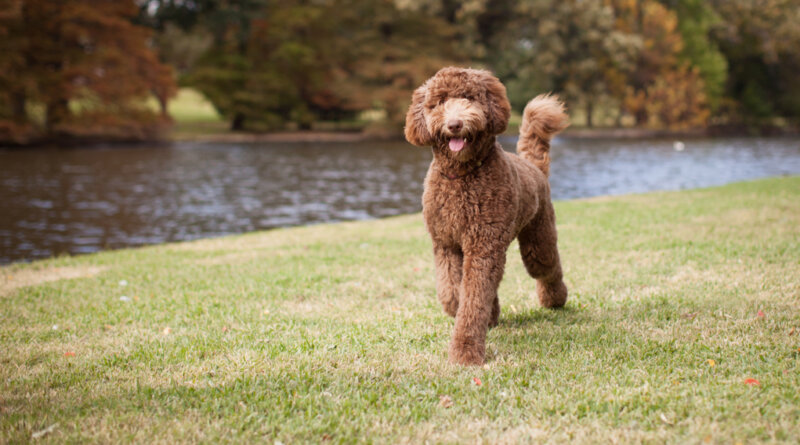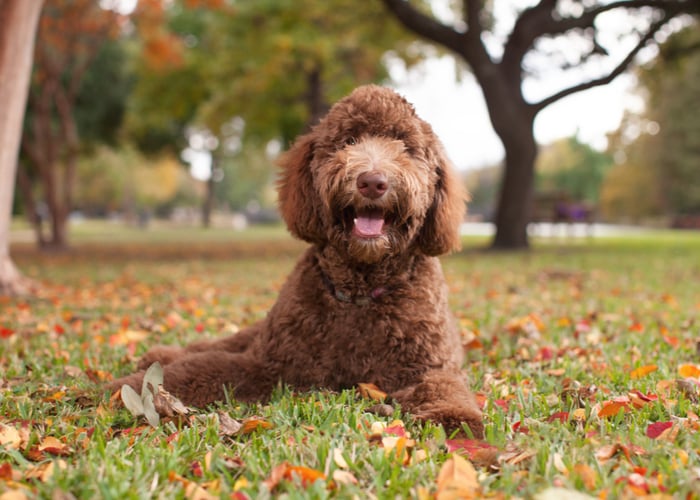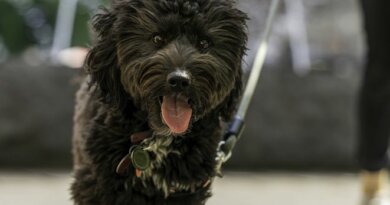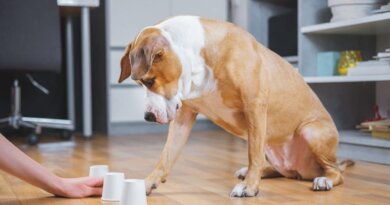Labradoodle Dog Breed Profile – Top Dog Tips
It shouldn’t be surprising that a Labradoodle gained a lot of popularity quickly. These dogs were initially bred as hypoallergenic guide dogs, as the first planned crosses of a Labrador Retriever and Poodle.
These pups were arranged by the Royal Guide Dogs Association of Australia. This hybrid resulted in a highly intelligent and friendly dog that offered a low-shedding coat.
Although the combination doesn’t provide consistent results in temperament or coat, they’re affectionate canines that remain popular.
As these dogs occasionally end up in rescues or shelters, always try to adopt a labradoodle when possible.
Labradoodle Overview
This “designer” pup became well known quickly with this extreme popularity. As this pup was bred to become a hypoallergenic service dog, the Labradoodle rapidly proved it could consistently help as a therapy dog while tapping into a versatile family dog.
The Labradoodle is always happiest when surrounded by the people they love, wanting to shower their family with devotion and affection.
This breed holds the energy of a Labrador Retriever and maintains the work ethic of both parents (Labrador and Poodle). Essentially, these pups might quickly become the most popular mixed breed for their versatility.
The Labradoodle approaches life head-on, maintaining breakneck speeds with almost unmatchable enthusiasm.
These pups do require a bit of training to help teach your new companion the best doggy etiquette. The Labradoodle is relatively easy to train, with high levels of intelligence and an eagerness to please.
These breeds often do well with other dogs and pets in the home. Labradoodles are reasonably good with children.
Due to their size and rather exuberant nature, they may unintentionally injure a small child through their boisterous personality.
Typically, these dogs make excellent pets for first-time dog owners.
The Labradoodle can be quiet and calm, curling up on your feet, but remain ready to jump into action playing a game of fetch at a moment’s notice. These dogs are not ideal for guarding, although they will regularly alert bark.
Unfortunately, these dogs will almost always encourage an intruder to come to play with them instead of keeping them out.
The Predictability of the Breed
Although many aspects of Labradoodles are lovely, most dogs fall short of the Royal Guide Dogs Association of Australia’s initial intent.
For instance, the most significant problem with Labradoodles at this time is the lack of consistency in any offspring.
These breeding inaccuracies occur when a Poodle is bred to Labs, or two Labradoodles are bred together. Unfortunately, this also includes the ability to use the breed as a guide dog.
With purebreds, many dogs hold specific characteristics that all breeds have in common: individual personalities. For instance, a border collie is going to herd something by instinct.
But, even with generational breeding, it seems Labradoodles lack the same consistency. Due to the hybrid’s popularity, the breeding holds further inconsistencies.
Unethical or careless breeding can add to this unpredictability. This usually happens particularly with irresponsible breeders unfamiliar with sound breeding practices
A few Labradoodles mimic the personalities of the Poodle. They bring more reserved, quiet natures with grand intelligence.
These dogs hold a high-maintenance coat that requires frequent and regular grooming.
A few poodles are excellent watchdogs, with some Labradoodles following suit. On the other hand, many Labradoodles follow a Labrador personality.
These pups are slow to mature, prone to shedding, and maintain a naturally goofy nature.
RELATED: Want to Reduce Your Dog’s Shedding By Up to 90 Percent?
Coat Discrepancies in Labradoodles
These coat differences are often the most significant discrepancy to arise between owners. The labradoodle was intended to remain low shedding (as the Poodle coat).
It’s still common to have multiple coat variations, along with discrepancies in the litter size. A few owners were forced to give up their pup because of shedding, inflicting symptoms because of the shedding.
Other individuals take care of a finely-textured Poodle coat, despite not having a purebred Poodle. This coat requires constant combing, trimming, and taking care of a fine coat. These coats often tend to mat and tangle.
Allergies to Dogs
Anyone allergic to dogs will likely be allergic to Labradoodles and any Doodle mixes. Many who are allergic to dogs don’t have an allergy to the coat as much as the dander.
The dander is small pieces of skin that come off the canine with any shed hair. Less shedding from the dog’s coat releases less dander into the environment.
Unfortunately, every situation is individual, with less shedding bringing less dander to react to. If you’re concerned about allergies, spend time with the mixed breed you intend to adopt.
Puppy Mills and Labradoodles
The sudden rise in popularity has caused Labradoodles to show up regularly in puppy mills and through irresponsible breeders. Many puppy mills will sell sickly puppies regardless of temperaments.
These designer dogs are highly attractive to irresponsible breeders, hoping to cash in on popularity over the pup’s quality. Many irresponsible breeders believe in finding two dogs of the same breed, and it’s far more complicated.
The Labradoodle stems from Labrador Retriever and Poodle cross-breeding. The sudden popularity has pushed more multigenerational breeding (Labradoodle to Labradoodle) and additional breeding between the Labradoodle and parent lineage.
This cross-breeding includes Labradoodle, Poodle, and Labrador Retriever combinations. Efforts to limit flawed breeding efforts have started among those organizations that support the breed.
Many organizations now offer direct referrals to high-quality or those promoting multigenerational breeders. Unfortunately, the high price tag doesn’t guarantee the quality, so always research the dog first.
RELATED: How to Find and Identify A Reputable Breeder
Labradoodle History
Wally Conron developed the original Labradoodle in Australia in 1989. Breeders intended the dog to offer guide dog services while maintaining a hypoallergenic status.
Wally Conron was in charge of the initial breeding program for the Royal Guide Dogs Association of Australia.
The first cross produced a pup called Sultan. The dog offered a hypoallergenic coat, along with high levels of intelligence.
It seemed the new breed held many qualities of a practical guide dog. Sultan successfully worked with a woman in Hawaii, bridging the gap between guide dogs and the hypoallergenic requirement.
Like the Labrador Retriever, the new Labradoodle quickly gained popularity and has since become one of the most sought-after “doodle breeds.”
These animals were originally bred through two purebred dogs but have slowly branched into multigenerational breeding.
Currently, the Australian Labradoodle Association and the International Australian Labradoodle Association are trying to implement registered status in the next few years.
The groups have made considerable efforts to achieve the same standards through multigenerational approaches to breeding programs.
Breed Sizing of the Labradoodle
Currently, the Labradoodle comes in three typical size variations, depending on the standard sizing of the Poodle. This sizing starts with the first-generation breeding, with sizing including Standard, Medium, and Miniature.
A standard Labradoodle should measure between 22 and 24 inches in height for a male and 21 to 23 inches for a female. Both genders range between 50 and 65 pounds.
The medium Labradoodle is a bit smaller in height, sitting at 18 and 20 inches high for a male and 17 and 19 inches for a female. Both breeds of this size weigh between 30 and 45 pounds.
Finally, the smallest Labradoodle stands between 14 and 16 inches tall and weighs between 15 and 25 pounds.
Unfortunately, these sizes are rough estimates. The breed can become considerably larger or smaller than expected.
Labradoodle: Understanding Personality Traits
The Labradoodle is a naturally intelligent dog that makes a beautiful family pet if trained. The pups are devoted to their family and enjoy life with an energetic companion. These dogs are friendly and accept anyone as their best friend.
These dogs are gentle but may show happiness through exuberant playing and jumping. Most of these dogs are naturally easygoing since breeders never bred the dog to be aggressive.
Unfortunately, as with any breed, some aren’t exceptionally friendly, but well-trained Labradoodles hold a characteristic temperament that is a true joy.
Temperament Guidelines for the Labradoodle
This dog’s temperament is influenced by many factors, including training, socialization, and heredity. Many puppies with friendly temperaments are curious and playful in nature.
They are willing to approach humans and be held by them. Always choose a middle-of-the-road pup when it comes to confidence.
You don’t want to select the puppy beating up their littermates, yet avoid the one hiding in the corner too.
Meeting the dog, you’re interested in before bringing them home is crucial. This interaction allows you to view the temperament first-hand.
It’s always a good idea to meet siblings, parents, and other relatives of the dog. These animals will better indicate how the puppy will look and act when they grow up.
As with every other breed, a Labradoodle will need early socialization. Exposure to many different people, sounds, sights, and experiences when they’re young can promote a healthy and well-rounded personality as an adult.
Puppy kindergarten classes are a fabulous way to start the socialization process, along with frequent walks around the neighborhood, visiting stores and parks, and interacting with people from an early age.
Labradoodle Health Conditions
Although the Labradoodle is primarily healthy, there are certain health conditions the dog can acquire with age. These include ear infections, thanks to their floppy ears.
As the ears trap moisture, they should be cleaned regularly and inspected for signs of infection. Likewise, the Labradoodle is prone to hip and elbow dysplasia.
These inherited conditions cause abnormal growth and development, resulting in malformed or weakened joints. Many of these conditions are diagnosed with x-rays, with arthritis being the most significant problem overall.
Epilepsy is a neurological condition that is most frequently inherited. This condition may cause mild or severe seizures that show unusual or atypical behaviors.
These traits may include running like they’re being chased, staggering, or hiding. It may also present as rigid limbs, losing consciousness, and falling down. Always take your dog to the vet for a proper diagnosis.
Finally, your Labradoodle may develop allergies over time. Allergies might include food, contact, or airborne.
Food and contact allergies will require avoiding the irritant, while the airborne allergen may require medications or environmental changes.
RELATED: Most Common Health Conditions in Dogs To Look Out For
Overall Care for a Labradoodle
Labradoodles will adapt to virtually any setting but should avoid apartments if possible. These dogs require 30 to 60 minutes of exercise daily, which works better within a fenced yard.
Occasionally, this breed will require more play time than this minimum, especially if they are first-generation pups.
The Labradoodle makes an exceptional jogging companion, but their exercise must extend beyond some leash time.
These dogs require mental stimulation, making them the perfect combination of intelligence and energy. If these pups become bored, they’re liable to become destructive and chaotic.
The Labradoodle is an intelligent dog that’s easy to please. Training efforts are relatively straightforward, provided there is consistency and positive reinforcement.
These dogs can make great companions for first-time dog owners, as they don’t require a lot of training or firm handling.
If they’re not socialized from puppyhood, they tend to hurl themselves into headlong canine situations without care or consideration for the other dogs. Unfortunately, this approach can pose significant issues if the other pup is aggressive.
The labradoodle is the happiest living close to their family, living inside the home with the ones they love. These dogs are meant for modern comforts like cozy beds and comfy blankets.
A Labradoodle can adjust to living in many different environments, from suburban and city locations to the quiet rural atmosphere. These dogs enjoy having a job to perform regularly, making them qualified for working roles.
Labradoodle Dog Breed Summary
The Labradoodle is an adaptable breed, despite the inconsistencies in litters. With the slight to moderate variances in size, color, coat, and personality, it’s hard to pinpoint the exact character you will receive.
Viewing the puppies is critical in your decision to add to your family, taking time to evaluate the personality of all pups and parents if possible.
Once you’ve chosen the best dog for your family, enjoy welcoming this funny and charismatic individual into your home with open arms.
The sweet and intelligent nature will become devoted to your family, while the playful and energetic side will keep you busy for years to come.
READ NEXT: 40 Most Incredible Mixed Breed Dogs
Related









